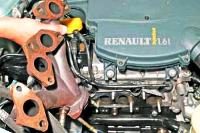In case of emergency braking of the car, it is necessary to maintain control over the car, reduce the likelihood of loss of control and blocking of the car's wheels due to loss of traction of the wheels with the road surface, which depends on the type of road surface, weather conditions and the actions of the driver.
The ABS system is designed to prevent such occurrences.
Increased traffic safety is achieved due to the fact that ABS prevents the wheels from locking when braking, even if the driver presses the brake pedal too hard and sharply, and allows you to maintain control of the car and not lose control over it. ABS makes it possible to avoid obstacles while braking.
In addition, ABS reduces the braking distance in case of poor grip on the road surface of individual wheels (wet, slippery or uneven road surface).
While the ABS system allows you to steer the vehicle with confidence during braking, it cannot improve the performance that is physically related to the traction conditions of the wheels, so it is important to follow the normal rules of safe driving, such as maintaining a safe distance from the front running car.
The fact that the car provides high traffic safety does not mean that you can take unreasonable risks.
When the ABS is turned on, a noticeable vibration of the brake pedal will appear.
This is a warning that the traction of the wheels has reached its limit and it is necessary to change the style of driving in accordance with the road conditions
In the event of an ABS failure, two situations are possible:
1. The orange indicator lamps "ABS" and "Service" light up on the instrument panel.
In this case, braking will occur as if the car does not have an ABS system.
It is necessary to contact a Renault workshop immediately.
2. On the instrument panel, the orange warning lamp "ABS", the red warning lamp for a brake system malfunction "Attention!", the warning lamps "Service" and "Stop" light up, and a corresponding message appears.
This indicates a problem with both the ABS and the braking system.
At the same time, the brake system of the car may partially remain operational.
However, hard braking is extremely dangerous, so stop immediately as soon as traffic conditions permit.
In this case, contact a Renault workshop immediately.
The pressure control of the service brakes by the ABS system is independent of the force applied to the brake pedal.
Therefore, in case of emergency braking, press the brake pedal firmly and continuously.
There is no need to resort to intermittent pedaling.
Emergency braking system
The emergency braking system complements the ABS system and allows you to shorten the braking distance of the car.
How it works
With the help of a sensor that measures the speed of pressing the brake pedal, the system can recognize emergency braking.
In this case, the emergency braking system instantly develops maximum braking force, which allows the ABS system to be activated faster.
ABS controlled braking is maintained as long as the brake pedal is depressed.
Emergency light alarm
In some vehicle configurations, when braking very hard, the direction indicators automatically turn on in the alarm mode.
The system allows you to better control the car during extreme driving and adapt it to your individual driving style.
However, this system does not replace driver skills.
It does not enhance the vehicle's capabilities and should not be a reason to drive at a higher speed.
Even with this system, while driving, you need to be careful and attentive (always ready for any surprises that may arise while driving).










